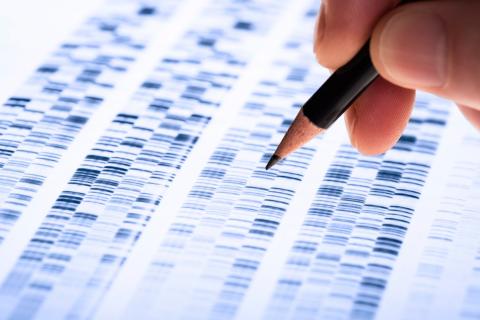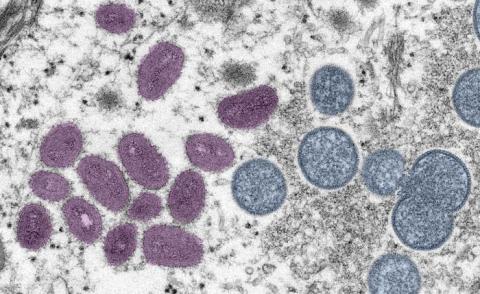Reactions: first draft of human pangenome published
In a series of three articles and a companion article - collected in Nature Biotechonology - Nature publishes the first draft of the human pangenome reference, which contains highly detailed data from 47 genetically diverse individuals. The first human genome was published more than two decades ago but, being from a single person, it does not represent human diversity, whereas the pangenome refers to the gene pool of our entire species. The ultimate goal of the Human Pangenome Reference Consortium project is to include genetic material from 350 people by 2024. It is hoped that this data will allow more clinically relevant genetic variants to be identified.

Graphical representation of the first draft of the human pangeome. Authors: Darryl Leja, NHGRI.
Gemma Marfany - pangenoma EN
Gemma Marfany
Professor of Genetics at the Universitat de Barcelona (UB) and head of group at CIBERER
This study is robust and of excellent technical and analytical quality. The researchers complement previous work that established the human reference genome (the so-called GRCh38), which has been used by all human genetics researchers in recent years.
[Previously] Massive mass sequencing work had produced a basic human reference genome, used both for genetic diagnosis and for comparison with other animal genomes. However, this reference genome had unfilled "gaps", was not sufficiently accurate in detecting structural variants and, having been derived from very few human genomes, could not be a reference for the great diversity of human populations.
This new genome is more global, as it contains information from 47 humans from very genetically diverse human populations, complementing the reference information. In addition, advances in mass sequencing have made it possible to contrast and complete many regions that had been poorly covered or even unknown. It was known that a large part of human genetic diversity lies in structural variants (large duplications and deletions), rather than in point variants. This new pangenome has discovered up to 1,115 new duplications adding nearly 119 million bases to the human genome (which contains 3.3 billion bases), a substantial improvement in quantity and quality.
In addition, it should be noted that the authors have attempted to obtain and map longer sequence reads than usual (thanks to novel massive long-read sequencing techniques), which allows better identification of the sequenced genome regions.
Are there any major limitations to be taken into account?
They have only been able to sequence the complete genomes of 47 people from very different origins (51% from Africa (which are the most genetically diverse), 34% from American genomes, 13% from Asian genomes, and only 2% from European genomes - the least because they are the most represented in genomic data). While this is a breakthrough, it cannot represent all human genetic variability. The researchers propose to sequence 350 more genomes, to increase representativeness and genetic diversity. On the other hand, there is still a relatively high sequencing error. Although this error is one base every 200,000 bases, as billions of bases are sequenced per individual, there is still an associated error that needs to be taken into account and improved in the future.
This new pangenome will become the new human reference genome that researchers will use in our daily activities. It will substantially improve genetic diagnosis, both of rare diseases and, especially, of complex diseases, in which structural variants have been a workhorse, as they were not easily detectable with the current reference genome and the techniques used until now. New algorithms will be developed that will allow for greater diagnostic accuracy.
This is not a conceptual leap, but a substantial advance in accuracy. The more knowledge we have about our genome, the greater the precision in the genetic inferences derived from the analysis of our genome, particularly with regard to precision medicine, also known as personalised medicine.
Marc Martí-Renom - pangenoma EN
Marc Martí-Renom
ICREA Research Professor at the Centre for Genomic Regulation and the National Centre for Genomic Analysis (CNAG)
This study is led by an international team of researchers from the US NIH's Human PanGenome project. Its ultimate goal is to characterise the genomic variability of the human population by sequencing and reassembling the genomes of 350 individuals of different origins.
More than 20 years ago, the Human Genome Project presented us with a vision of the human genome of a single individual. This genome was completed only a year ago with the sequencing of the repetitive parts of the genome.
However, in human populations there is a lot of gene variability that, together with the environment, makes us different. With the work presented today, the genome of 47 humans representing different geographical areas of the planet has been reassembled. In other words, 47 projects have been made like the original Human Genome.
Although each of these reassembled genomes may still contain errors and only represent a limited number of individuals, this work paves the way towards more accurate personalised medicine for any patient regardless of their geographical origin.
Wen-Wei Liao et al.
- Research article
- Peer reviewed
- People
Mitchell R. Vollger et al.
- Research article
- Peer reviewed
- People
Andrea Guarracino et al.
- Research article
- Peer reviewed
- People
Glenn Hickey et al.
- Research article
- Peer reviewed
- Modelling



